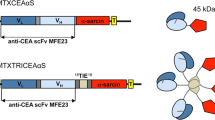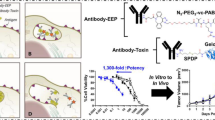Summary
Anti-carcinoembryonic antigen (CEA) immunotoxins constructed with multiple anti-CEA antibodies (goat and baboon polyclonal, and three murine monoclonal antibodies) by covalently linking them to the A chain of ricin via a disulfide bond all function as potent and specific toxins for CEA-bearing cells, suggesting that the CEA molecule is capable of directing productive internalization of ricin A chain. The high potency of anti-CEA immunotoxins apparently makes addition of ricin B chain unnecessary for high toxic efficiency, as in some other systems, because presence of the B chain reduces target cell specificity. Several characteristics of the immunotoxins which might account for their cytotoxic potency were studied. Equilibrium association constants of the goat, baboon, and murine monoclonal C-19 antibodies with fluid-phase CEA were determined by using Langmuir plots and were found to be 8.79, 6.61, and 8.13×109 M −1, respectively, indicating the high and similar affinities of the three antibodies toward CEA. Radioimmunoassay binding studies of the three immunotoxins with 125I-CEA showed that the antibody portions of the molecules retained the ability to form complexes with CEA after conjugation to ricin A chain. The maximum number of anti-CEA antibody molecules bound per cell, as demonstrated by 111In-labeled C-19 binding assays with CEA-bearing cell lines, varied from 2.65×105 per cell for HT29 to 2.01×106 for LoVo, with an intermediate value of 1.17×106 per cell for WiDr. Cytotoxicity of the immunotoxins was assessed by inhibition of protein synthesis and expressed as a median inhibitory dose (ID50). Comparison of the ID50's of each immunotoxin on the three cell lines has shown that the immunotoxin made of the monoclonal C-19 antibody is in general 6 to 7 times more cytotoxic than the goat and baboon antibody immunotoxins. The affinity of CEA-antibody binding is probably an important, but not a sole factor in determining the immunotoxin potency. The fact that the antibodies with very similar affinity toward fluid phase CEA make immunotoxins of different potency might indicate that interactions with membrane-bound CEA are more complex and/or the efficiency of internalization of various immunotoxins is different. An important factor in immunotoxin action appears to be the CEA content in target adenocarcinoma cells.
Similar content being viewed by others
References
Day ED (1972) Advanced immunochemistry. Williams and Wilkins, p 181
Drewinko B, Yang L-Y (1980) Observations on the synthesis of carcinoembryonic antigen by an established human colonic carcinoma cell line. Oncology 37:336
FitzGerald DJP, Trowbridge IS, Pastan I, Willingham MC (1983) Enhancement of toxicity of anti-transferrin receptor antibody-Pseudomonas exotoxin conjugates of adenovirus. Proc Natl Acad USA: 80:4134
Griffin TW, Haynes LR, DeMartino JA (1982) Selective cytotoxicity of a ricin A chain anti-carcinoembryonic antigen antibody conjugate for a human colon adenocarcinoma cell line. J Natl Cancer Inst 69:799
Haagensen DE, Jr Cox Ch E, Dilley WG, Hensley M, Murdoch J, Newman ES, Wells SA Jr (1980) Evaluation of baboon antiserum to carcinoembryonic antigen. Clin Chem 26:1787
Hansen HJ, Lance KP, Krupey J (1971) Demonstration of an ion-sensitive antigenic site on carcinoembryonic antigen using zirconyl phosphate gel. Clin Res 19:143
Hnatowich DJ, Childs RL, Lanteigne D, Najafi A (1983) The preparation of DTPA-coupled antibodies radiolabeled with metallic radionuclides: an improved method. J Immunol Methods 65:147
Hurley JP, Haagensen Jr DE, Hansen JH, Zamcheck N (1986) Capture and detection of carcinoembryonic antigen on antibody coated beads used in enzyme immunoassay. J Immunoassay (in press)
Levin LV, Griffin TW, Haynes LR, Sedor CJ (1982) Selective cytotoxicity for a colorectal carcinoma cell line by a monoclonal anticarcinoembryonic antigen antibody coupled to the A chain of ricin. J Biol Response Mod 1:149
Levin LV, Childs LR, Griffin TW (1986) Flow cytometry analysis of anti-carcinoembryonic antigen antibody and immunotoxin (IT) internalization by LoVo cells. Proceedings of the American Association for Cancer Research p 1461
Mason DW, Williams AF (1980) The kinetics of antibody binding to membrane antigens in solution and at the cell surface. Biochem J 187:1
Neville DM, Jr Youle RJ (1982) Monoclonal antibody-ricin or ricin A chain hybrids: kinetic analysis of cell killing for tumor therapy. Immunol Rev 62:75
Newman ES, Petras EE, Georgiadis A, Hansen HJ (1974) Interrelationship of carcinoembryonic antigen and colon carcinoma antigen-III. Cancer Res 34:2515
Old LJ, Stockert E, Boyse EA, Kim JH (1968) Antigenic modulation. Loss of TL antigens from cells exposed to TL antibody. Study of the phenomenon in vitro. J Exp Med 127:523
Olsnes S, Pihl A (1982) Chimaeric toxins. In: Cohen P, Van Meyringen S (eds) The molecular action of toxins and viruses. Elsevier, Amsterdam, p 51
Raso V, Ritz J, Basala M, Schlossman SF (1982) Monoclonal antibody-ricin A chain conjugate selectively cytotoxic for cells bearing the common acute lymphoblastic leukemia antigen. Cancer Res 42:457
Rosenthal KL, Tompkins WAF, Rawls WE (1980) Factors affecting the expression of carcinoembryonic antigen at the surface of cultured human colon carcinoma cells. Cancer Res 40:4744
Vitetta ES, Krolick KA, Miyama-Inaba M, Cushley W, Uhr JW (1983) Immunotoxins: A new approach to cancer therapy. Science 219:644
Youle RJ, Neville DM Jr (1982) Kinetics of protein synthesis inactivation by ricin-anti-Thy 1.1 monoclonal antibody hybrids. J Biol Chem 257:1598
Author information
Authors and Affiliations
Additional information
Supported in part by the NIH BRSG grant ✠ SO7RRO5712, the American Cancer Society, Mass. Div. Research Grant ✠ 1543-C-1, and by the Aid for Cancer Research (Boston) award to L. V. L., and by RO1 CA 29160 and RO1 CA 39748 grants to T. W. G.
Rights and permissions
About this article
Cite this article
Levin, L.V., Griffin, T.W., Childs, L.R. et al. Comparison of multiple anti-CEA immunotoxins active against human adenocarcinoma cells. Cancer Immunol Immunother 24, 202–206 (1987). https://doi.org/10.1007/BF00205630
Received:
Accepted:
Issue Date:
DOI: https://doi.org/10.1007/BF00205630




